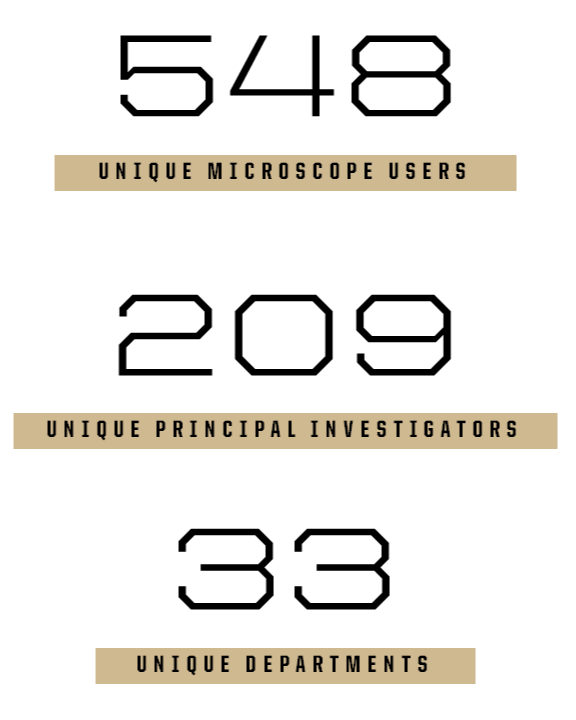Purdue day of giving - April 30, 2025
why donate to the Purdue electron Microscopy center?
At the Purdue Electron Microscopy Center (PEMC), our focus is to delight, inspire, and educate the current generation of researchers and the next! If you were inspired by electron microscopy, or find it delightful and wish you had heard about it years ago, donate to the PEMC on this Purdue Day of Giving to help us provide electron microscopy for generations to come!
Thank you to all who donated during Purdue Day of Giving! The event is now over, and the donation link has been disabled.
Thank you to all who donated during Purdue Day of Giving! The event is now over, and the donation link has been disabled.
Our Stats from the Last Twelve Months
Our best statistic is the number of students, research groups, and departments we support. Your support helps us continue to provide excellence in electron microscopy to help all scientific fields drive their research forward.

Outreach
Your donation to the PEMC helps with outreach and education of learners of all ages. Throughout the year, we are involved with outreach covering a range of ages from toddler through graduate students and beyond. Our electron microscopes are not just hidden away for only graduate students to use; we are continuously striving to educate the general public about the beauty and wonder that is revealed by electron microscopy.
Our involvement with outreach includes participation in the Purdue College of Agriculture's Spring Fest, an event which is designed for all ages to learn more about the natural world. Both children and adults were fascinated by the detail and intricacies found in nature that are only visible through the high magnification images that electron microscopy provides.
You can read more about our presence at Spring Fest here.
Each summer, Rosa Diaz organizes a 2 week summer camp for middle-schoolers to learn about a range of scientific topics and get hands-on experience with some of the high end equipment we have on campus. The camp is typically focused on biomimicry, and the electron microscopes allow the students to see small structures of butterfly wings, examine tardigrades, and look at the surface texture of leaves, among other things. These students end the camp by presenting a poster summarizing what they learned and coming up with real-world applications involving biomimicry.
Each fall, the undergraduates in ABE 226 have the opportunity to find, isolate, and grow bacteriophage over the course of the semester. At the very end of the semester, they are able to come and see the phage that they have spent all semester analyzing and finally see them with their own eyes with the help of one of our transmission electron microscopes (TEM). Professor Kari Clase runs this class every year and Amanda Limiac works closely with the students throughout the semester, including visiting us each year to enjoy the TEM while helping to prepare samples to go into the microscope.
Undergraduates in Materials Engineering have the opportunity to work with industry partners as part of their Senior Design projects where they are able to help solve real-world problems. These undergraduates gain hands-on experience with a wide range of instrumentation for materials characterization over the course of their project and many of them are trained to use our scanning electron microscopes (SEMs) as part of their project. We see lots of frantic use at the end of each fall semester as undergraduates are putting the finishing touches on their projects!
Our involvement with outreach includes participation in the Purdue College of Agriculture's Spring Fest, an event which is designed for all ages to learn more about the natural world. Both children and adults were fascinated by the detail and intricacies found in nature that are only visible through the high magnification images that electron microscopy provides.
You can read more about our presence at Spring Fest here.
Each summer, Rosa Diaz organizes a 2 week summer camp for middle-schoolers to learn about a range of scientific topics and get hands-on experience with some of the high end equipment we have on campus. The camp is typically focused on biomimicry, and the electron microscopes allow the students to see small structures of butterfly wings, examine tardigrades, and look at the surface texture of leaves, among other things. These students end the camp by presenting a poster summarizing what they learned and coming up with real-world applications involving biomimicry.
Each fall, the undergraduates in ABE 226 have the opportunity to find, isolate, and grow bacteriophage over the course of the semester. At the very end of the semester, they are able to come and see the phage that they have spent all semester analyzing and finally see them with their own eyes with the help of one of our transmission electron microscopes (TEM). Professor Kari Clase runs this class every year and Amanda Limiac works closely with the students throughout the semester, including visiting us each year to enjoy the TEM while helping to prepare samples to go into the microscope.
Undergraduates in Materials Engineering have the opportunity to work with industry partners as part of their Senior Design projects where they are able to help solve real-world problems. These undergraduates gain hands-on experience with a wide range of instrumentation for materials characterization over the course of their project and many of them are trained to use our scanning electron microscopes (SEMs) as part of their project. We see lots of frantic use at the end of each fall semester as undergraduates are putting the finishing touches on their projects!
Thank you to all who donated during Purdue Day of Giving! The event is now over, and the donation link has been disabled.
Thank you to all who donated during Purdue Day of Giving! The event is now over, and the donation link has been disabled.
Please send any questions/comments/concerns regarding the content on this page to snbienz@purdue.edu.